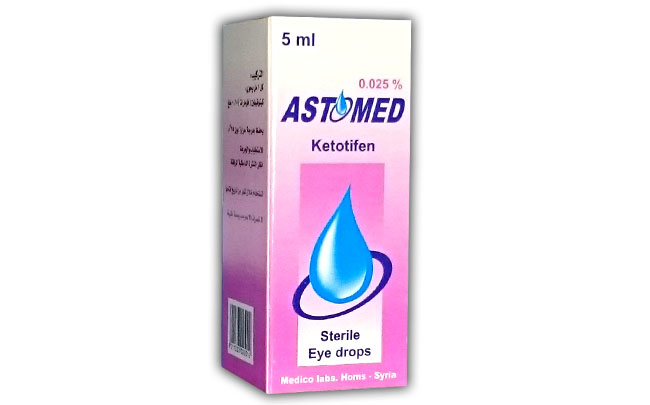Description:
CLINICAL PHARMACOLOGY:
Ketotifen is a relatively selective, non-competitive histamine antagonist
(Hydrogen (H1)-receptor) and mast cell stabilizer. Ketotifen inhibits the release of mediators from cells
involved in hypersensitivity reactions. Decreased chemotaxis and activation of eosinophils has also been
demonstrated.
INDICATIONS AND USAGE:
ASTOMED is indicated for the temporary prevention of itching of the eye due to allergic conjunctivitis.
CONTRAINDICATIONS:
ASTOMED is contraindicated in persons with a known hypersensitivity to any component of this product.
WARNINGS:
For topical ophthalmic use only. Not for injection or oral use .
Information For Patients:
– To prevent contaminating the dropper tip and solution, care should be taken not to touch the eyelids or surrounding areas with the dropper tip of the bottle.
– Keep the bottle tightly closed when not in use
– Patients should be advised not to wear a contact lens if their eye is red.
– ASTOMED should not be used to treat contact lens related irritation.
– The preservative in ASTOMED, benzalkonium chloride, may be absorbed by soft contact lenses.
– Patients who wear soft contact lenses and whose eyes are not red, should be instructed to wait at least ten minutes after instilling ASTOMED before they insert their contact lenses.
Pregnancy: Pregnancy Category C.
It is also not known whether ASTOMED can cause fetal harm when administered to a pregnant woman
or can affect reproduction capacity.
ASTOMED should be given to a pregnant woman only if clearly needed.
Nursing Mothers:
It is not known whether topical ocular administration could result in sufficient systemic absorption to
produce detectable quantities in breast milk. Nevertheless, caution should be exercised when ketotifen
fumarate is administered to a nursing mother
Pediatric Use:
Safety and effectiveness in pediatric patients below the age of 3 years have not been established
ADVERSE REACTIONS:
In controlled clinical studies, conjunctival injection, headaches, and rhinitis were reported at an incidence of 10 to 25%. The occurrence of these side effects was generally mild. Some of these events were similar to the underlying ocular disease being studied.
The following ocular and non-ocular adverse reactions were reported at an incidence of less than 5%
Ocular: Allergic reactions, burning or stinging, conjunctivitis, dry eyes, eye pain, eyelid disorder,
itching, keratitis, lacrimation disorder, mydriasis, photophobia, and rash.
Non-Ocular: Flu syndrome, pharyngitis.
DOSAGE AND ADMINISTRATION:
The recommended dose is one drop in the affected eye(s) twice daily, every 8 to 12 hours
STORAGE:
– Store below 25°C.
– Keep container tightly closed.
How Supplied: 5 ml in plastic bottle

